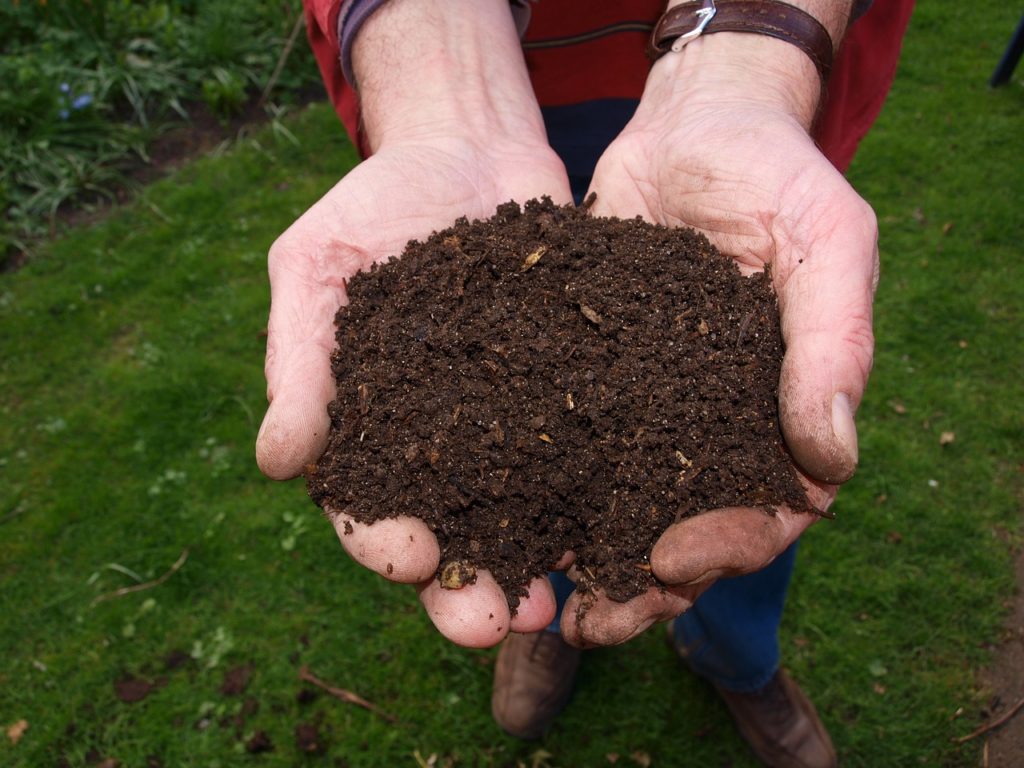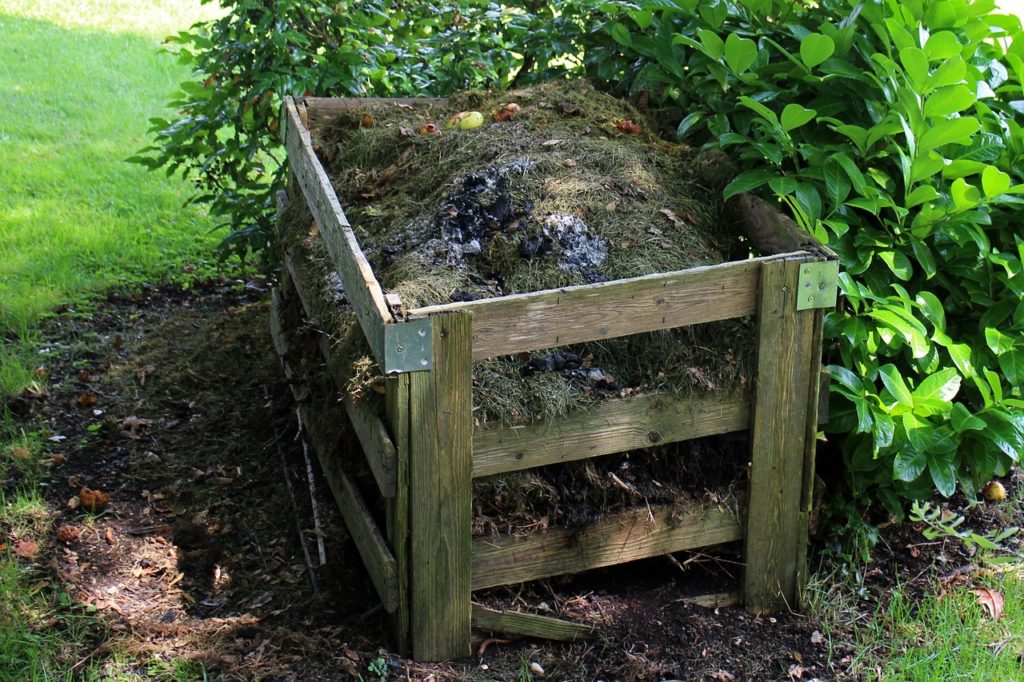What is Composting?
Composting is recycling your biodegradable garden and kitchen wastes and turning them into a valuable resource for your garden or houseplants. This is done by speeding up the process that the materials you use to compost go through on their own – decomposition.
Compost is an organic substance that is added to the soil which functions more than just being a fertilizer. It is a mulch, a soil conditioner, and something that will help the soil give the best nutrients and minerals your plants need. With compost, the soil also is able to hold more water, which is also beneficial to your plants.
Compost is not soil. It is a common misconception that the end-result of composting is the dirt that you find in the ground.

Before you begin composting there are choices to be made – what type of container and style suits your project, what you will be putting into your compost bin, and the location of your bin.
But regardless of these decisions, how you convert your waste into compost happens the same way. It is a breakdown of waste materials as they are digested by microbes (bacteria and fungi).
The microbes are the workers of the composting equation. They need air, water, and food to do their job and it is up to you to supply it to them in the right amounts.
What to do with the Foul odor coming from the compost
If you have heard that having a compost bin or pile creates a foul odor it is most likely the result of not enough air circulating throughout the waste material. Without air, the material will still breakdown but it will be done by anaerobic microbes (organisms that do not need oxygen) as opposed to aerobic (ones that need oxygen).
So if you do have an unpleasant smell coming from your compost bin or pile you can rotate the material to let in more air or add a substance to create more room for the air to circulate. Wood chips or hay are good for this.
What are the Benefits of Composting?
Composting is good for the environment and your garden. It eliminates the amount of waste you throw away and enriches the soil your plants grow in.
Besides a free and nutrient rich fertilizer for your soil and plants, there are many other benefits to starting a compost in your yard. Here are some of the benefits of composting:
- You can reduce or eliminate weeds in your garden by using compost as it prevents weed seeds from sprouting and prospering. This is a natural alternative to pesticides.
- Mature compost material has been used to stop or prevent erosion in certain areas. The binding capability in the compost can keep the soil in place and prevent dangerous drop-offs.
- Reducing the amount of organic material that goes to a dump unnecessarily – in turn this reduces the amount of methane gas a dump creates during decomposition.
- In wetlands areas that are in trouble, compost has been used to revitalize the soil and surrounding plant life.
- Healthier plants, compost material can prevent your plants from contracting diseases that kill or spread to the rest of the crop or garden.
- Can create a stable and healthier pH balance in your soil.
- If your soil is overly dry (sandy), adding compost to the soil and thoroughly mixing can help the sandy dirt retain more water keeping it moist.
- If your soil is clay-like, you can make the dirt easier to work with and less dense by adding mature compost.
- Provides important nutrients and micro-nutrients to the soil and plants.
- Increases the temperature of the soil creating a conducive environment for plant growth and health.
This is just a few of the important benefits that can be derived from using compost. It helps the environment, your garden, your plants and the planet. The small amount of time that it takes to set-up and maintain a compost bin or pile is well worth the time and effort.
What are the Methods in Composting
There are several composting methods which you can employ or use. The so called “no-turn” composting method seems to be the easiest. Like what the title of the method indicates, you don’t need to turn the pile of compost at least once every week to quicken the process of decomposition. In this “no-turn” technique, all you need to do is add a lot of coarse materials to your compost.

Adding a lot of straw would do just fine. What the straw does is to create air pockets and allow the pile to be aerated. You can expect your compost to be developed at the same rate as when you employ the traditional “turn-over” composting technique. When you use this composting technique, be sure to get your compost from the bottom of the pile. Just add new organic materials on the top keeping in mind adding coarse materials as well.
If the only available composting materials in your yard are piles and piles of leaves, then don’t worry.
Creating composts from leaves alone can be done. You just need a couple of things, and some very simple techniques. Select a place where you will make your compost pile. For the leaves, the place ideal would be a well shaded area which will help keep the pile damp or moist. Also keep in mind that the pile should not be packed tightly. Keep it loose to allow the air to circulate.
In four or six months, the compost from leaves should be finished and ready to be applied to the soil. Take a mental note, however, that the compost created from the leaves does not contain enough nutrients and microorganism to function as a fertilizer. The finished compost, however, is great as soil conditioner.
When composting, you will need materials rich in carbon and nitrogen namely fruits and vegetable scraps and other table scraps except left over bones because they attract a number of pests and animals. Other products include eggshells, grass or shrub clippings, pine needles, seaweed and kelp, coffee grounds, wood ash, tea leaves, cardboard and shredded paper, corn stalks, wood chips, and sawdust.

To discourage fruit flies and other pests from grouping together on your pile, it would be best to cover the pile or add lime or calcium over the top or whenever you add new materials to your compost. The lime and calcium also help neutralize the odors from your pile.
Composting at Home: How to Make Compost Bin DIY
If you would rather not purchase a compost bin for your compost pile, you should still devise a way to contain it. You can easily and inexpensively make your own compost bin. This will give you more control over the size of the pile and can prevent unwelcome animals helping themselves to some free food.
It’s not difficult to make a compost bin. You can do it yourself or “DIY”.
Look in your storage room or garage and look for suitable materials and most likely you will find some quite suitable ones. They can be made from heavy plastics or wood or tin.
Wire Mesh, Wood Planks and Pipes
One of my suggestions would be using a wire mesh, a couple of wood planks or even pipes. The idea would be like creating a simple wired fence around your compost pile with the pieces of wooden planks or pipes as support. You can tie the wire mesh to the pipes or planks to make it more secure. The shape is up to you. You can make it round, square, rectangular or even triangle shaped.
Just keep in mind that you will need to have quick access to the compost pile to turn it over at least once each week. You can create a doorway from the wire mesh or you can make your enclosure in such a way that you can easily lift and put back the whole enclosure.

Wooden Slats or Planks for Compost Bin
Also, if you have some left over wooden slats from an old fence or wooden planks from an old shed, I’m sure you can assemble a quite sturdy compost bin in your backyard. Just make sure to let the air in by allowing spaces between the wooden boards. This will keep the air flowing inside the compost pile make decomposition quicker. If you have enough loose boards lying around, you can create a dresser-type compost bin complete with a door with hinges for easy access to the compost pile.
Garbage Can for Compost Bin
You can even fashion one from your garbage can. Look for an old can where you can afford to experiment without being scolded by your wife or your mother later on. What you need to do is punch a couple of holes in your garbage can to allow the air to circulate in the soon composting materials. You just put your composting materials inside the can. Before you cover it, wet the materials inside until they appear damp.
You can turn over or roll it around to let the materials mix while always keeping the compost pile damp. When storing the trashcan compost bin, if would be best to place it above ground. In a month or so, you should be able to get satisfactory results from all your effort.
Recycled Lumber for Compost Bin
If you are using recycled lumber and it has been treated (either painted or stained) make sure it has been done using non-toxic material. You do not want anything toxic or poisonous to come in contact with your compost, especially if you are going to be using it where you are growing food.
Here’s what you will need:
- Four 4-foot sections of 2X4 and
- Twenty 3-foot sections of 1X6 boards.
Steps on How to Make a Compost Bin:
Step 1:
Begin by hammering the 2X4 lumber pieces into the ground with a sledgehammer at the corners of what will become a 3 feet squared container (space each corner post 3 feet apart).
Step 2:
Put five boards to every side securing each end of the board to the corner post with nails. Be sure to leave enough room in between each board for air circulation. You can use a piece of plywood or another flat piece of material large enough to cover the top as a cover.
You see, making your own compost bin is very easy. You just need to consider the following fundamentals:
- air should flow inside the bin
- you should have quick access to the compost pile, and
- you should be able to wet the pile when needed
There are a number of compost bins commercially available in various garden stores. You can buy it if you have the money or you can do what I did, make your own compost bin.
Some commercially available compost bins have their own systems or devices for turning over the compost. Some have harvesting trays or mechanisms for easier harvest. But those things are just add-ons and are made for added convenience for the consumer.
You really don’t need such stuff. All you need is basic enclosures to keep the compost materials from being scattered around the area.
